
High school student Quienten Anger measuring nitrate value in the Chippewa River with Professor J. Brian Mahoney. Willow Anderson in the background.
What’s the best way to get high school students interested in water sciences? Get their feet wet, literally. That’s just what 14 students did last summer when they participated in the Freshwater Science Summer Field Experience, funded by a grant through the Freshwater Collaborative of Wisconsin.
Spearheaded by Dr. J. Brian Mahoney, geology professor at UW-Eau Claire, the summer short course involved experiences led by faculty from UW-Eau Claire, UW Oshkosh, UW-River Falls and UW-Stout. Funding from the Freshwater Collaborative of Wisconsin allowed students to participate at no cost. They also had the option to pay tuition to earn two college credits at one of the participating institutions.
“We tried to introduce the students to as many different aspects of freshwater science as we could,” Mahoney says. “We kind of fire-hosed these kids, and they soaked it up. They loved it.”

Biology professor Dave Lonzarich electrofishing to catalog fish in Little Niagra Creek. Students (L:R) Owen Wiggen, Gabe Girard, Willow Anderson, Quienten Anger
Over the course of six days, students kayaked on Halfmoon Lake to explore the fish and wetlands; studied the hydrogeology and biology of the rivers running through UW-Eau Claire’s campus; visited the Minnesota Zoo to look at invasive species with faculty from UW-River Falls; traveled to Door County to research Great Lakes beaches and contamination and run lab tests with UW Oshkosh faculty; and investigated algal blooms and stream flows in Menomonie with UW-Stout faculty.
For Emma Johnson, a senior at Memorial High School in Eau Claire, the program opened her eyes to the career possibilities she can pursue with her post-secondary education. Johnson is considering a degree in environmental science and learned about the program through her high school science teacher. She was immediately interested.
Her favorite experience was going to Door County to research microplastics in Lake Michigan. She appreciated that she was able to conduct the same kind of research and testing that a college student would — and that it was applicable.“

Emma Johnson and Maddy Knauff measure groundwater properties at a UW Eau Claire well field.
It seemed like a really great opportunity to learn a lot about something that’s so valuable to us, especially in Wisconsin,” she says. “Water is such an important resource that we are always going to need to maintain. There’s always going to be jobs in that area.”
“It was applying general ideas to the real world. That’s what environmental sciences is about,” she says. “I had a lot of new opportunities that I wouldn’t have been able to have experienced without taking this course.”
A bonus was that participating in the program gave Johnson insight into what life as a college student would be like.
“This gave me an idea of how to communicate with professors and ask them questions,” Johnson says. “It wasn’t as intimidating as I thought it would be. The professors were there to help you. I was very free to learn.”
Mahoney has wanted to create a program to help recruit high school students to UW-Eau Claire and connect to nearby universities. The summer course provided students the opportunity to visit four UW campuses and learn from 11 faculty members and two undergraduate mentors. The feedback was beyond expectations, and the group hopes to continue the course, with a different institution taking the lead each year.
“This kind of collaboration is exactly what we’ve been talking about with the Freshwater Collaborative of Wisconsin,” Mahoney says. “We’re hoping this will be a model for other institutions to do similar collaborative efforts.”
See more Freshwater Collaborative of Wisconsin research stories.
